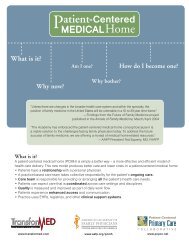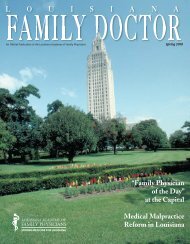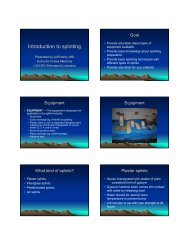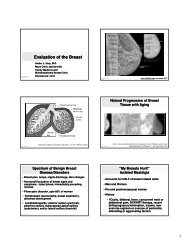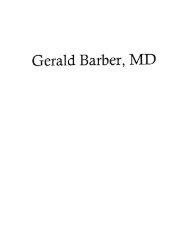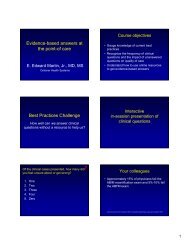New Drug Update 2009-2010 - LAFP
New Drug Update 2009-2010 - LAFP
New Drug Update 2009-2010 - LAFP
You also want an ePaper? Increase the reach of your titles
YUMPU automatically turns print PDFs into web optimized ePapers that Google loves.
Observed<br />
cases<br />
17.3% 32.8% (P = 0.003) 32.8% (P < 0.001)<br />
Week 27<br />
BOCF/LOCF 13% 18.3% (P = 0.245) 18.1% (P = 0.105)<br />
Observed<br />
cases<br />
19.4% 33.3% (P = 0.056) 31.9% (P = 0.017)<br />
Fibromyalgia pain treatment (>/= 30% reduction in pain scores)<br />
Week 15<br />
BOCF 19.3% 27.2% (P = 0.056) 26.8% (P = 0.032)<br />
Observed<br />
cases<br />
27.2% 45.2% (P = 0.003) 45.4% (P < 0.001)<br />
Week 27<br />
BOCF/LOCF 18.4% 25.9% (P = 0.072) 25.6% (P = 0.034)<br />
Observed<br />
cases<br />
27.9% 43.8% (P = 0.021) 45.2% (P = 0.001)<br />
Another randomized, double-blind, phase 3 study that assessed milnacipran 200 mg/day compared with<br />
placebo in 884 patients with fibromyalgia was reported in a meeting abstract. The majority of patients<br />
were women (94.3%), with a mean age of 48.8 years. Patients received placebo (449 patients) or<br />
milnacipran 200 mg/day (435 patients) for 12 weeks. The primary end point, fibromyalgia composite<br />
response, was defined as patients with at least 30% improvement in 24-hour recall pain and a rating of<br />
“very much improved” or “much improved” on the PGIC scale. Overall impact on symptomatology was<br />
assessed with the FIQ total score. Milnacipran exhibited greater improvement relative to placebo in the<br />
composite response (P = 0.0003; results not provided) and in the FIQ total score (P = 0.015). Greater<br />
improvement with milnacipran than placebo was also observed for secondary end points, including<br />
weekly pain on e-diary, Brief Pain Inventory (BPI), SF-36 Mental and Physical components,<br />
Multidimensional Fatigue Inventory total score, FIQ physical function subscale score, and the MASQ<br />
cognition total score (Eur Neuropsychopharmacol. 2008;18(suppl 4):S574-S575).<br />
Milnacipran was also evaluated in a randomized, double-blind, dose-escalation study enrolling 125<br />
patients with fibromyalgia. Mean age was 46.2 to 48 years; 96% to 98% of patients in each treatment<br />
group were women, and 79% to 89% were white. The mean duration of fibromyalgia ranged from 3.8 to<br />
4.3 years, and most patients had used multiple nondrug treatment modalities (eg, acupuncture,<br />
antiepileptics, chiropractic, diet, exercise, hot-cold packs, massage, physical therapy). Patients were<br />
assigned to receive milnacipran twice daily, milnacipran once daily, or placebo for 3 months using a3:3:2<br />
ratio. All previous antidepressants, centrally acting muscle relaxants, hypnotics, and opioids and their<br />
derivations had to be discontinued over a period of 1 to 4 weeks. Stable doses of NSAIDs, aspirin, and<br />
acetaminophen were allowed during the study. Following a 2-week baseline observation period, patients<br />
were randomized to therapy with placebo (28 patients), milnacipran 25 mg once daily (46 patients), or<br />
milnacipran 12.5 mg twice daily (51 patients). If doses were tolerated, dose escalation was completed<br />
weekly to 50, 100, and then 200 mg once daily, or 25, 50, and then 100 mg twice daily over a 4-week<br />
period. Patients were then continued at a stable dose for an additional 8 weeks. There was no difference<br />
in the rate of discontinuation of drug therapy (30.4% with milnacipran once daily, 27.5% with milnacipran<br />
twice daily, and 25% with placebo). Dose escalation to the target dose of 200 mg was achieved in 92% of<br />
patients assigned twice-daily administration and 81% of those assigned once-daily administration. The<br />
mean daily dose of milnacipran was 174 mg in the once-daily group and 191 mg in the twice-daily group.<br />
The primary end point was the change in pain recorded on e-diary during the final 2 weeks of the trial<br />
compared with the average pain scores during the 2-week baseline period. All analysis was intent-to-treat<br />
with LOCF. Improvements in pain, global well-being, and fatigue were observed in both active-treatment<br />
groups; however, twice-daily administration was associated with more improvements compared with<br />
placebo. Pain scores are summarized in Table 5. Response was defined as a 30% or 50% reduction in<br />
62




